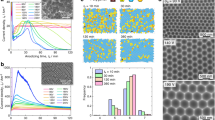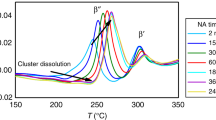Abstract
Porous anodic alumina (PAA) films are widely used as templates for functional nanostructures, because of the high regularity and controllability of the pore morphology. However, growth mechanisms have not yet been developed that can explain quantitative relationships between processing conditions and oxide layer geometry. Here, we present a model for steady-state growth of these amorphous films, incorporating the novel feature that metal and oxygen ions are transported by coupled electrical migration and viscous flow. The oxide flow in the model arises near the film–solution interface at the pore bottoms, in response to the constraint of volume conservation. The hypothesis of viscous flow was successfully validated through detailed comparisons to observations of the motion of tungsten tracers in the film. Predictions of localized tensile stress near nanoscale ridges at the metal–film interface were supported by observations of voids at these sites. We suggest that the ordering of PAA may be explained by a mechanism in which metal–film interface motion is regulated by the combination of ionic migration in the oxide and stress-driven interface diffusion of metal atoms.
This is a preview of subscription content, access via your institution
Access options
Subscribe to this journal
Receive 12 print issues and online access
$259.00 per year
only $21.58 per issue
Buy this article
- Purchase on Springer Link
- Instant access to full article PDF
Prices may be subject to local taxes which are calculated during checkout




Similar content being viewed by others
References
Thompson, G. E. & Wood, G. C. in Anodic Films on Aluminium. Corrosion: Aqueous Processes and Passive Films (ed. Scully, J. C.) 205–329 (Academic, 1983).
Masuda, H. & Fukuda, K. Ordered metal nanohole arrays made by a 2-step replication of honeycomb structures of anodic alumina. Science 268, 1466–1468 (1995).
Li, A. P., Müller, F., Birner, A., Nielsch, K. & Gösele, U. Hexagonal pore arrays with a 50–420 nm interpore distance formed by self-organization in anodic alumina. J. Appl. Phys. 84, 6023–6026 (1998).
Ono, S., Saito, M., Ishiguro, M. & Asoh, H. Controlling factor of self-ordering of anodic porous alumina. J. Electrochem. Soc. 151, B473–B478 (2004).
Lee, W., Ji, R., Gösele, U. & Nielsch, K. Fast fabrication of long-range ordered porous alumina membranes by hard anodization. Nature Mater. 5, 741–747 (2006).
Macak, J. M. et al. TiO2 nanotubes: Self-organized electrochemical formation, properties and applications. Curr. Opin. Solid State Mater. Sci. 11, 3–18 (2007).
Parkhutik, V. P. & Shershulsky, V. I. Theoretical modeling of porous oxide growth on aluminum. J. Phys. D. 25, 1258–1263 (1992).
Thamida, S. K. & Chang, H. C. Nanoscale pore formation dynamics during aluminum anodization. Chaos 12, 240–251 (2002).
Singh, G. K., Golovin, A. A. & Aranson, I. S. Formation of self-organized nanoscale porous structures in anodic aluminum oxide. Phys. Rev. B 73, 205422 (2006).
O’Sullivan, J. P. & Wood, G. C. The morphology and mechanism of formation of porous anodic films on aluminium. Proc. R. Soc. Lond. A. 317, 511–543 (1970).
Cherki, C. & Siejka, J. Study by nuclear microanalysis and O18 tracer techniques of the oxygen transport processes and the growth laws for porous anodic oxide layers on aluminum. J. Electrochem. Soc. 120, 784–791 (1972).
Siejka, J. & Ortega, C. An O18 study of field-assisted pore formation in compact anodic oxide films on aluminum. J. Electrochem. Soc. 124, 883–891 (1977).
Houser, J. E. & Hebert, K. R. Modeling the potential distribution in porous anodic alumina films during steady-state growth. J. Electrochem. Soc. 153, B566–B573 (2006).
Skeldon, P., Thompson, G. E., Garcia-Vergera, S. J., Iglesias-Rubianes, L. & Blanco-Pinzon, C. E. A tracer study of porous alumina. Electrochem. Solid-State Lett. 9, B47–B51 (2006).
Garcia-Vergera, S. J., Skeldon, P., Thompson, G. E. & Habazaki, H. A flow model of porous anodic film growth on aluminium. Electrochim. Acta 52, 681–687 (2006).
Garcia-Vergera, S. J., Skeldon, P., Thompson, G. E. & Habazaki, H. Tracer studies of anodic films formed on aluminum in malonic and oxalic acids. Appl. Surf. Sci. 254, 1534–1542 (2007).
Garcia-Vergera, S. J., Skeldon, P., Thompson, G. E. & Habazaki, H. Self-generated porosity in anodic alumina formed in sulphuric acid electrolyte. Corros. Sci. 49, 3772–3782 (2007).
Bradhurst, D. H. & Leach, J. S. L. Mechanical properties of thin anodic films on aluminum. J. Electrochem. Soc. 113, 1245–1249 (1966).
Wüthrich, N. Intrinsic stresses in anodic films on aluminium. Electrochim. Acta 26, 1617–1623 (1981).
Volkert, C. A. Stress and plastic flow in silicon during amorphization by ion-bombardment. J. Appl. Phys. 70, 3521–3527 (1991).
Volkert, C. A. & Pohlman, A. Radiation-enhanced plastic flow of covalent materials during ion irradiation. Mater. Res. Soc. Symp. Proc. 235, 3–14 (1992).
Mayer, T. M., Chason, E. & Howard, A. J. Roughening instability and ion-induced viscous relaxation of SiO2 surfaces. J. Appl. Phys. 76, 1633–1643 (1994).
Mayr, S. G., Ashkenazy, Y., Albe, K. & Averback, R. S. Mechanisms of radiation-induced viscous flow: Role of point defects. Phys. Rev. Lett. 90, 055505 (2003).
Eernisse, E. P. Viscous flow of thermal SiO2 . Appl. Phys. Lett. 30, 290–293 (1977).
De Graeve, I., Terryn, H. & Thompson, G. E. Influence of local heat development on film thickness for anodizing aluminum in sulfuric acid. J. Electrochem. Soc. 150, B158–B165 (2003).
Moon, S. M. & Pyun, S. I. The mechanism of stress generation during the growth of anodic oxide films on pure aluminum in acidic solutions. Electrochim. Acta 43, 3117–3126 (1998).
Ebihara, K., Takahashi, H. & Nagayama, M. Structure and density of anodic oxide films formed on aluminum in sulfuric acid solutions. J. Met. Finish. Soc. Jpn. 33, 156–164 (1982).
Ebihara, K., Takahashi, H. & Nagayama, M. Structure and density of anodic oxide films formed on aluminum in oxalic acid solutions. J. Met. Finish. Soc. Jpn. 34, 548–553 (1983).
Suo, Z., Kubair, D. V., Evans, A. G., Clarke, D. R. & Tolpygo, V. K. Stresses induced in alloys by selective oxidation. Acta. Mater. 51, 959–974 (2003).
Suo, Z. A continuum theory that couples stress and self-diffusion. J. Appl. Mech. 71, 646–651 (2004).
Houser, J. E. Modeling the steady-state growth of porous alumina. PhD Dissertation (Iowa State Univ., 2008).
Vrublevsky, I., Parkoun, V., Schreckenbach, J. & Marx, G. Effect of the current density on the volume expansion of the deposited thin films on aluminum during porous oxide formation. Appl. Surf. Sci. 220, 51–59 (2003).
Valand, T. & Heusler, K. E. Reactions at the oxide-electrolyte interface of anodic oxide films on aluminum. J. Electroanal. Chem. 149, 71–82 (1983).
Habazaki, H., Shimizu, K., Skeldon, P., Thompson, G. E. & Wood, G. C. The composition of the alloy-film interface during anodic oxidation of Al–W alloys. J. Electrochem. Soc. 143, 2465–2470 (1996).
Kodeba, E. & Irene, E. A. SiO2 film stress distribution during thermal oxidation of Si. J. Vac. Sci. Tech. B 6, 574–578 (1988).
Nelson, J. C. & Oriani, R. A. Stress generation during anodic oxidation of titanium and aluminum. Corros. Sci. 34, 307–326 (1993).
Vanhumbeeck, J.-F. & Proost, J. On the contribution of electrostriction to charge-induced stresses in anodic oxide films. Electrochim. Acta 53, 6165–6172 (2008).
Kolics, A., Polkinghorne, J. C. & Wieckowski, A. Adsorption of sulfate and chloride ions on aluminum. Electrochim. Acta 43, 2605–2618 (1998).
Rajan, S. S. S. Sulfate adsorbed on hydrous alumina, ligands displaced, and changes in surface charge. Soil Sci. Soc. Am. J. 42, 39–44 (1978).
He, L. M., Zelazny, L. W., Baligar, V. C., Ritchey, K. D. & Martens, D. C. Ionic strength effects on sulfate and phosphate adsorption on γ-alumina and kaolinite: Triple-layer model. Soil Sci. Soc. Am. J. 61, 784–793 (1997).
Paul, K. W., Kubicki, J. D. & Sparks, D. L. Quantum chemical calculations of sulfate adsorption at the Al- and Fe-(Hydr)oxide-H2O interface—estimation of Gibbs free energies. Environ. Sci. Tech. 40, 7717–7724 (2006).
Chason, E., Sheldon, B. W., Freund, L. B., Floro, J. A. & Hearne, S. J. Origin of compressive residual stress in polycrystalline thin films. Phys. Rev. Lett. 88, 156103 (2002).
Ono, S., Ichinose, H. & Masuko, N. Defects in porous anodic films formed on high purity aluminum. J. Electrochem. Soc. 138, 3705–3710 (1991).
Ono, S., Ichinose, H. & Masuko, N. Lattice images of crystalline anodic alumina formed on a ridged aluminum substrate. J. Electrochem. Soc. 139, L80–L81 (1992).
Asoh, H., Ono, S., Hirose, T., Takatori, I. & Masuda, H. Detailed observations of cell junction in anodic porous alumina with square cells. Jpn. J. Appl. Phys. 43, 6342–6346 (2004).
Mei, Y. F., Wu, X. L., Shao, X. F., Huang, G. S. & Siu, G. G. Formation mechanism of alumina nanotube array. Phys. Lett. A 309, 109–113 (2003).
Lee, W., Schwirn, K., Steinhart, M., Pippel, E., Scholz, R. & Gösele, U. Structural engineering of nanoporous anodic aluminium oxide by pulse anodization of aluminium. Nature Nanotech. 3, 234–239 (2008).
Mackrodt, W. C. & Tasker, P. W. Surfaces and interfaces in oxides. Chem. Br. 21, 366–369 (1985).
Schwirn, K. et al. Self-ordered anodic aluminum oxide formed by H2SO4 hard anodization. ACS Nano 2, 302–310 (2008).
Garcia-Vergera, S. J. et al. Incorporation of gold into porous anodic alumina formed on an Al–Au alloy. J. Electrochem. Soc. 155, C333–C339 (2008).
Acknowledgements
This research was supported financially by the National Science Foundation (DMR-0605957) and by St. Jude Medical Corp.
Author information
Authors and Affiliations
Corresponding author
Supplementary information
Supplementary information
Supplementary information (PDF 759 kb)
Rights and permissions
About this article
Cite this article
Houser, J., Hebert, K. The role of viscous flow of oxide in the growth of self-ordered porous anodic alumina films. Nature Mater 8, 415–420 (2009). https://doi.org/10.1038/nmat2423
Received:
Accepted:
Published:
Issue Date:
DOI: https://doi.org/10.1038/nmat2423
This article is cited by
-
Well-defined nanostructuring with designable anodic aluminum oxide template
Nature Communications (2022)
-
Self-ordered nanospike porous alumina fabricated under a new regime by an anodizing process in alkaline media
Scientific Reports (2021)
-
Effect of anodic oxygen evolution on cell morphology of sulfuric acid anodic alumina films
Journal of Solid State Electrochemistry (2021)
-
Nano-porous anodic alumina: fundamentals and applications in tissue engineering
Journal of Materials Science: Materials in Medicine (2020)
-
The role of barrier layer temperature in the formation of long and small-diameter TiO2 nanotube arrays
Journal of Porous Materials (2020)



